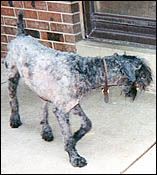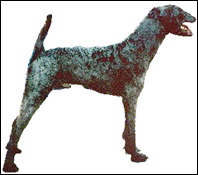How To Identify A Kerry Blue Terrier
by Lisa Frankland
The Kerry Blue Terrier is a medium-sized breed with a soft, wavy coat similar to a Poodle. The overall impression is of a sturdy, active, moderately built, and unexaggerated large terrier. Most Kerries are friendly and affectionate with humans, but may exhibit dog-aggressiveness with dogs of the same sex. They are typically fearless, playful, and intelligent, with a delightful sense of humor.



Physical Characteristics
Color:
Puppies are born black and gradually “clear” to their adult color by the time they are two years old. The mature coat color is generally determined by genetics, not a Kerry’s age, and may range all the way from solid black to light silver, and all shades in between. Medium to dark blue-gray is most typical. Lighter colored dogs may have darker points on their face, tail, and feet, while younger Kerries in the process of “clearing” to their adult color may have small patches of tan or brown, especially on the legs.
Trim:
Kerries are usually trimmed in a distinctive terrier style, with profuse facial furnishings, a beard and longer hair on the legs. However,
pets may have these furnishings clipped short or completely removed, while neglected Kerries may have long hair (up to eight inches) all over,
including on the head.
Size:
Generally ranges from 17 to 21 inches in height and 30 to 45 lbs in weight.
Ears:
Ears are moderately small and terrier-like, though some specimens may have ears that “fly” (even standing straight up) or hang in a hound-like
fashion. Puppies may have their ears “pasted” to their heads in order to encourage them to set up correctly.
Tail:
The tail is usually carried straight up, and docked to a length of about six inches, though very rarely dogs may be docked shorter.
Breeds Kerry Blues May Be Mistaken For
Poodle or Poodle Mix:
Kerries are larger than Miniature Poodles and smaller than Standard Poodles. A Kerry’s muzzle is not as fine, its ears smaller and set higher on the dog’s head, and its front and rear angulation is not as extreme. Unlike a Poodle, a trimmed Kerry has a terrier-like trim, especially the face.
Bouviers:
Kerries are much smaller than purebred Bouviers, which may weigh over 80 pounds (a large Kerry weighs 45 pounds). A Kerry’s ears are never cropped short, and the docked tail is much longer. A Kerry’s head is rectangular, not broad and square like a Bouvier’s. Kerries are never brindle or fawn color, and have soft, dense, wavy, single coats, unlike the straight, harsh, double coats of Bouviers.
Schnauzer (particularly Standard and Giant):
While both Kerries and Schnauzers may be black, Kerries are never salt-and-pepper, and never have the wire-haired coat of a Schnauzer. Kerries do not have cropped ears like most Schnauzers, and the docked tail is much longer. A Kerry’s facial furnishing are typically much more profuse.
Airedale:
Kerries are never black and tan or wire-haired like purebred Airedales. Kerries are not nearly as tall or leggy, and the tail is shorter.
Scottish Terrier:
Kerries may be black or gray, but never wheaten or brindle, and never wire-haired. Kerries have floppy ears, not prick ears. A
Kerry’s legs are much longer than a Scottish Terrier’s, and are in proportion to its body.
Soft-Coated Wheaten Terrier:
Kerries are never light blonde color. A Kerry’s coat is wavy and has more body to it (like a Poodle’s) than the Wheaten’s straight and silky coat. A Kerry’s ears are normally smaller and higher set.
This information was written to help animal rescue organizations correctly identify the Kerry Blue Terrier.
Last Updated: 05/03/2004, 6:10 pm




